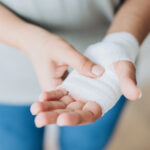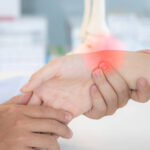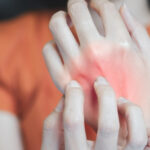Burtom ‣ Departments ‣ Hand and Microsurgery
Language: 🇬🇧 English | 🇹🇷 Türkçe

Hand and Microsurgery Department Overview

The Hand and Microsurgery Department specializes in intricate procedures for the hand, fingers, and nerves. This department employs advanced techniques, including microsurgery, to address injuries, deformities, and reconstructive needs. Surgeons perform delicate procedures such as nerve repair, tendon transfers, and microvascular surgery. The focus is on restoring optimal function and aesthetics, ensuring comprehensive care for patients with complex hand-related conditions. The department’s expertise lies in combining precision, innovation, and specialized care to enhance patients’ hand health and quality of life.
Key Functions of an Hand and Microsurgery

The key functions of a Hand and Microsurgery department include:
Diagnosis and Assessment: Conducting thorough evaluations to diagnose and assess hand-related injuries, deformities, and conditions.
Surgical Interventions:
- Performing intricate surgical procedures with a focus on the hand, fingers, nerves, and microvascular structures.
Reconstructive Surgery: Offering reconstructive surgeries to address traumatic injuries, congenital deformities, or acquired conditions affecting hand function.
Microsurgical Techniques: Utilizing advanced microsurgical techniques, including the use of microscopes, to achieve precision in delicate procedures such as nerve repair and tissue reconstruction.
Tendon Transfers: Conducting tendon transfer procedures to restore function and improve hand mobility.
Joint Reconstruction: Performing joint reconstruction surgeries for conditions such as arthritis or joint deformities affecting hand movement.
Peripheral Nerve Surgery: Specializing in surgeries related to peripheral nerves, addressing conditions like carpal tunnel syndrome or nerve injuries.
Postoperative Rehabilitation: Collaborating with rehabilitation specialists to provide comprehensive postoperative care, including physical therapy for optimal recovery.
Emergency Hand Trauma Care: Offering emergency care for acute hand trauma, providing immediate interventions to minimize long-term impact.
Patient Education: Educating patients on hand health, injury prevention, and postoperative care to empower them in their recovery process.
Collaboration with Other Specialties: Collaborating with other medical specialties, such as orthopedics and plastic surgery, for multidisciplinary care in complex cases.
Research and Innovation: Engaging in research and staying abreast of technological advancements to bring innovative solutions to hand and microsurgery.
The Hand and Microsurgery department plays a critical role in enhancing the quality of life for individuals with hand-related conditions through a combination of advanced surgical techniques, rehabilitation, and patient-centered care.
Situations within the scope of Hand and Microsurgery

Situations within the scope of Hand and Microsurgery include:
Traumatic Hand Injuries: Treatment of hand injuries resulting from accidents, falls, or occupational incidents, ranging from fractures and dislocations to soft tissue injuries.
Reconstructive Hand Surgery: Reconstruction of hands affected by congenital anomalies, burns, tumors, or injuries, aiming to restore functionality and aesthetics.
Nerve Compression Disorders: Management of nerve compression disorders, such as carpal tunnel syndrome, through surgical interventions to relieve pressure on the affected nerves.
Tendon Injuries: Repair and reconstruction of damaged tendons due to injuries or conditions affecting hand movement.
Joint Disorders: Surgical interventions for joint disorders, arthritis, or deformities affecting hand joints, including joint reconstruction procedures.
Microvascular Surgery: Microvascular procedures to address complex conditions, such as replantation of amputated fingers, using advanced techniques to restore blood supply.
Congenital Hand Deformities: Correction of congenital hand deformities in children, ensuring optimal hand development and function.
Peripheral Nerve Injuries: Surgical management of peripheral nerve injuries, including repair, grafting, or transfer procedures to restore nerve function.
Dupuytren’s Contracture: Treatment of Dupuytren’s contracture, a condition causing finger contractures, through surgical techniques such as fasciotomy or fasciectomy.
Hand Tumors: Excision and reconstruction of benign or malignant tumors affecting the hand or fingers.
Thumb Reconstruction: Surgical procedures to reconstruct the thumb, including thumb replantation or reconstruction in cases of traumatic amputation or deformity.
Trigger Finger Release: Surgical release procedures for trigger finger, a condition causing the finger to lock or catch during movement.
Degenerative Joint Conditions: Management of degenerative joint conditions in the hand, such as osteoarthritis, through joint-preserving or joint-replacement procedures.
Emergency Hand Trauma: Immediate surgical interventions for emergency hand trauma cases, including crush injuries, lacerations, or avulsions.
The Hand and Microsurgery specialty addresses a broad spectrum of situations, ranging from acute trauma to congenital anomalies, utilizing advanced surgical techniques to optimize outcomes and restore hand function.
Patient Experience in the Hand and Microsurgery

The patient experience in Hand and Microsurgery is characterized by a comprehensive and personalized approach to care, aiming to address hand-related conditions with precision and compassion. Key aspects of the patient experience in this specialty include:
Initial Consultation: Thorough assessments during the initial consultation to understand the patient’s medical history, symptoms, and specific concerns related to hand function.
Clear Communication: Open and clear communication between the surgeon and the patient to discuss diagnoses, treatment options, and potential outcomes.
Educational Support: Providing educational resources and information about the proposed surgical procedures, expected recovery, and postoperative care to empower patients in making informed decisions.
Patient-Centered Care: Tailoring treatment plans to the individual needs and preferences of the patient, considering factors such as lifestyle and expectations.
Preoperative Counseling: Offering preoperative counseling to alleviate concerns and anxieties, explaining the surgical process, and addressing any questions or uncertainties.
State-of-the-Art Facilities: Access to state-of-the-art facilities equipped with advanced technologies and microsurgical tools to ensure the highest level of precision in procedures.
Multidisciplinary Collaboration: Collaboration with rehabilitation specialists and other healthcare professionals for comprehensive care before and after surgery, focusing on optimal recovery.
Postoperative Support: Ongoing support and follow-up care to monitor progress, manage any postoperative issues, and guide patients through the rehabilitation process.
Rehabilitation Services: Access to rehabilitation services, including physical therapy, to enhance hand function, promote healing, and optimize the overall outcome.
Empathy and Compassion: Demonstrating empathy and compassion throughout the patient’s journey, acknowledging the emotional aspects of hand-related conditions and the impact on daily life.
Outcome Monitoring: Regularly monitoring and assessing outcomes to ensure that treatment goals are met, making adjustments as needed for the best possible results.
Patient Satisfaction: Seeking feedback from patients to assess their satisfaction with the care received, identifying areas for improvement, and continuously enhancing the patient experience.
The patient experience in Hand and Microsurgery centers on delivering not only high-quality surgical interventions but also compassionate and supportive care. From the initial consultation to the postoperative period, patients are guided through a personalized treatment journey that prioritizes their well-being and the restoration of optimal hand function.
Conclusion

In conclusion, the field of Hand and Microsurgery is dedicated to providing specialized and precise care for individuals facing a range of hand-related conditions. With a focus on surgical interventions, advanced microsurgical techniques, and patient-centered care, this specialty aims to restore optimal hand function and aesthetics. The patient experience in Hand and Microsurgery is characterized by comprehensive assessments, clear communication, educational support, and compassionate care throughout the treatment journey.
By leveraging state-of-the-art facilities, multidisciplinary collaboration, and rehabilitation services, Hand and Microsurgery professionals work to enhance the quality of life for their patients. The emphasis on empathy, understanding the emotional impact of hand conditions, and continuous monitoring of outcomes contributes to a holistic and satisfactory patient experience.
Ultimately, the combination of precision in surgical procedures, individualized care plans, and ongoing support positions Hand and Microsurgery as a vital specialty in addressing a diverse range of hand-related situations. Patients can expect not only optimal medical interventions but also a compassionate and collaborative approach aimed at achieving the best possible outcomes.
Medical Devices Used in the Hand and Microsurgery

Medical devices play a crucial role in Hand and Microsurgery, aiding surgeons in performing precise procedures and ensuring optimal outcomes. Here are some commonly used medical devices in this specialized field:
Microscopes: High-powered surgical microscopes are essential for magnifying and illuminating small structures during microsurgical procedures. They provide the surgeon with a detailed view of tissues and blood vessels.
Microsurgical Instruments: Specialized microsurgical instruments, including delicate forceps, scissors, needle holders, and clamps, are designed for use in intricate procedures requiring precision.
Surgical Loupes: Magnifying eyewear or surgical loupes worn by surgeons to enhance their vision and precision during intricate hand and microsurgical procedures.
Microsurgical Sutures: Ultra-fine sutures designed for microsurgery, allowing surgeons to meticulously close incisions and repair delicate tissues with minimal trauma.
Vascular Clamps: Microvascular clamps are used to temporarily block blood vessels during microsurgery, facilitating procedures such as vascular anastomosis.
Tourniquets: Tourniquets may be employed to temporarily restrict blood flow during certain hand surgeries, providing a bloodless field for the surgeon.
Dermatomes: Dermatomes are used for precision in skin grafting procedures, allowing surgeons to harvest thin layers of skin for transplantation.
Nerve Stimulators: Nerve stimulators assist surgeons in locating and identifying nerves during procedures, particularly in nerve repair or transfer surgeries.
Electrocautery Devices: Electrocautery devices are used for precise tissue cutting and coagulation, helping control bleeding during surgery.
External Fixation Devices: External fixation devices may be utilized for stabilizing fractures or supporting the hand during the healing process.
Fluoroscopy Devices: In certain cases, fluoroscopy devices may be used for real-time imaging during hand and microsurgical procedures, aiding in accurate placement of implants or assessing joint alignment.
Ultrasonic Bone Cutters: Ultrasonic bone cutters provide a controlled and precise method for bone cutting in orthopedic hand surgeries.
Intraoperative Nerve Monitoring Systems: These systems monitor nerve function in real-time during surgery, helping to prevent nerve damage and improve outcomes in nerve-related procedures.
Pulse Oximeters: Pulse oximeters monitor oxygen saturation levels in the blood during surgery, ensuring patient safety.
These medical devices are integral to the success of Hand and Microsurgery procedures, enabling surgeons to navigate the complexities of delicate structures and promote optimal patient outcomes. The choice and use of these devices are guided by the specific needs of each surgical intervention.
Areas of interest

Get a Free Second Opinion

I consent to Burtom Health Group using my aforesaid personal data for the purposes described in this notice and understand that I can withdraw my consent at any time by sending a request to info@burtom.com.














